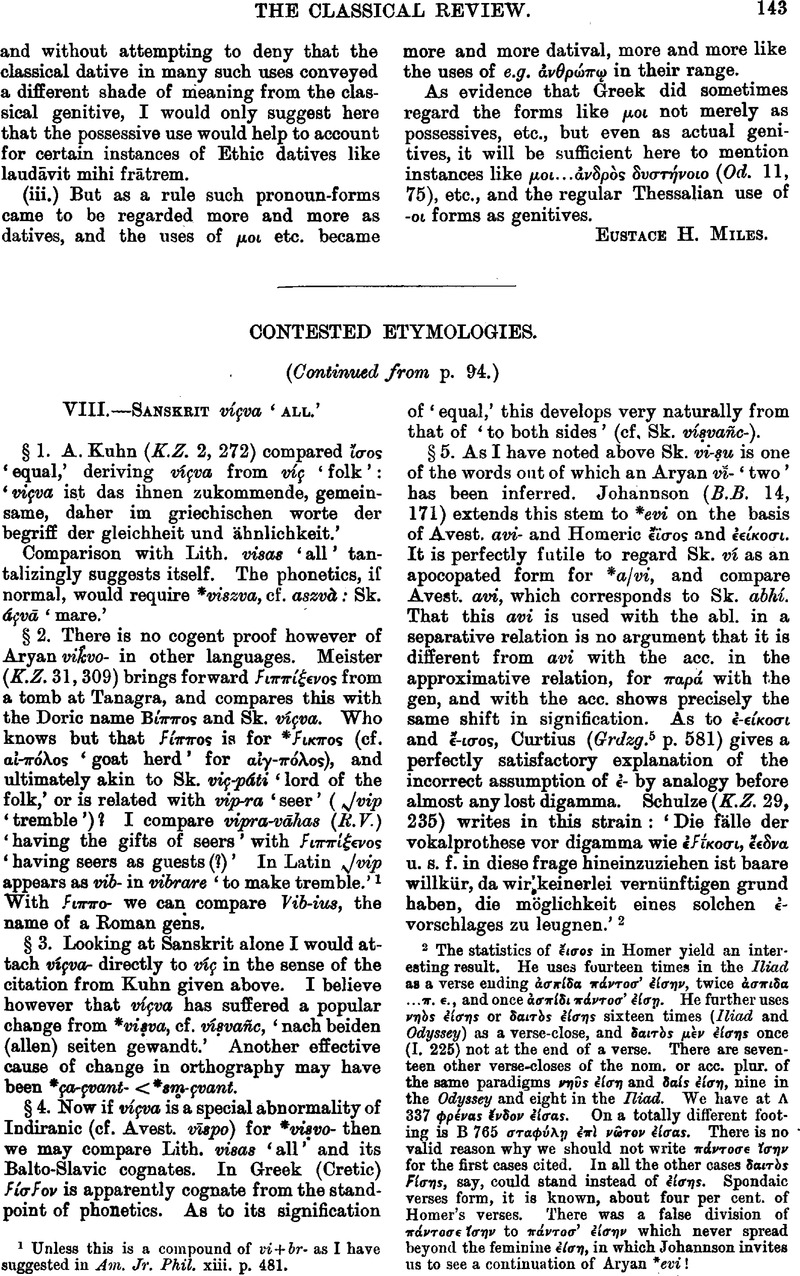No CrossRef data available.
Article contents
Contested Etymologies
Published online by Cambridge University Press: 27 October 2009
Abstract

- Type
- Review Article
- Information
- Copyright
- Copyright © The Classical Association 1897
References
page 143 note 1 Unless this is a compound of vi+br- as I have suggested in Am. Jr. Phil. xiii. p. 481.
page 143 note 2 The statistics of ἔισ∘ς in Homer yield an interesting result. He uses fourteen times in the Iliad as a verse ending ⋯σπ⋯δα π ⋯ντ∘σ' ⋯⋯σην, twice ⋯σπιδα …π, ɛ., and once ⋯σπ⋯διπ⋯ντ∘σ ⋯⋯ση. He further uses νη⋯ς ⋯⋯σης or δαιτ⋯ς ⋯⋯σης sixteen times (Iliad and Odyssey) as a verse-close, and δαιτ⋯ς μ⋯ν ⋯⋯ση once (I. 225) not at the end of a verse. There are seventeen other verse-closes of the nom. or ace. plur. of the same paradigms ![]() and δα⋯ς ⋯⋯ση, nine in the Odyssey and eight in the Iliad. We have at A 337 φρ⋯νασ ἔνδ∘ν ⋯⋯σας. On a totally different footingis B 765
and δα⋯ς ⋯⋯ση, nine in the Odyssey and eight in the Iliad. We have at A 337 φρ⋯νασ ἔνδ∘ν ⋯⋯σας. On a totally different footingis B 765 ![]() . There is no valid reason why we should not write π⋯ντ∘σε ἴσην for the first cases cited. In all the other cases δαιτ⋯ς ϝ⋯σης, say, could stand instead of ⋯⋯σης. Spondaic verses form, it is known, about four per cent, of Homer's verses. There was a false division of π⋯ντ∘σε ἴσην to π⋯ντ∘σ' ⋯⋯σην which never spread beyond the feminine ⋯ιση, in which Johannson invites us to see a continuation of Aryan *evi!
. There is no valid reason why we should not write π⋯ντ∘σε ἴσην for the first cases cited. In all the other cases δαιτ⋯ς ϝ⋯σης, say, could stand instead of ⋯⋯σης. Spondaic verses form, it is known, about four per cent, of Homer's verses. There was a false division of π⋯ντ∘σε ἴσην to π⋯ντ∘σ' ⋯⋯σην which never spread beyond the feminine ⋯ιση, in which Johannson invites us to see a continuation of Aryan *evi!
page 144 note 1 I had a negro man-servant tell me once at a door: Mr. Fay, the young ladies both of ‘em are all out.’
page 144 note 2 For the etymology of sēpio, see below xi, § 2.
page 144 note 3 Wharton (Et. Lat. s.vv.) further derives cunctus from cingo ‘gird’ (!), and omnis from ob-in the sense of ‘comprehensive,’ (!).
page 146 note 1 In view of the assimilations seen in Sk. sas, Lith szeszi ‘six’ the form *ksveks set down as the oldest Aryan form by Prellwitz (Et. Wört. s.v. ἕξ) is to be regarded as a form with assimilated spirant group reaching back into the primitive period (i.e. *ksvehs is for *sveks).




